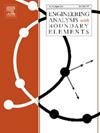Machine learning applied to estate pricing for residential rentals in dynamic urban markets—The case of São Paulo city
IF 4.2
2区 工程技术
Q1 ENGINEERING, MULTIDISCIPLINARY
Engineering Analysis with Boundary Elements
Pub Date : 2024-10-08
DOI:10.1016/j.enganabound.2024.105988
引用次数: 0
Abstract
This study conducts a comprehensive investigation into real estate rental pricing in São Paulo city, employing an innovative approach that combines advanced machine learning techniques with geospatial and natural language processing (NLP) analyses. The research analyzed a robust dataset comprising 47,243 rental listings, gathered through web scraping techniques. Following a rigorous data cleaning and preprocessing procedure, the study focused on 35,486 instances, incorporating a variety of variables that go beyond conventional metrics, including textual descriptions and geographic information, enriching the analysis and market understanding. Several regression models were implemented and compared, including linear approaches, Support Vector Machines, and ensemble methods such as Gradient Boosting, LightGBM, and XGBoost. The Blending model, which integrates multiple modeling techniques, stood out as the most accurate, achieving a Root Mean Squared Logarithmic Error (RMSLE) of 0.2923 on the test set. This result emphasizes the superiority of hybrid modeling strategies in complex pricing tasks. The findings of this study have significant practical implications. They provide landlords and tenants with a powerful data-driven tool for informed decision-making, reflecting the nuances and complexity of São Paulo’s real estate market. The practical implementation of the model in an interactive web application not only demonstrates its utility in the real-world scenario but also serves as a model for future applications in real estate analysis. This work contributes to mitigating the waste of time and energy when it comes to searching for and pricing residential rentals in a large city, through the use of machine learning that shows its power and potential in accurately estimating rental prices in dynamic urban markets, allowing that more assertive and economical decisions can be taken within a social-sustainable-technological perspective.
将机器学习应用于动态城市市场住宅租赁的房地产定价--圣保罗市的案例
本研究采用创新方法,将先进的机器学习技术与地理空间和自然语言处理(NLP)分析相结合,对圣保罗市的房地产租赁定价进行了全面调查。该研究分析了一个强大的数据集,其中包括通过网络刮擦技术收集的 47,243 份租房信息。经过严格的数据清理和预处理程序后,研究重点放在 35,486 个实例上,并纳入了各种超出传统指标的变量,包括文本描述和地理信息,从而丰富了分析和市场理解。实施并比较了几种回归模型,包括线性方法、支持向量机以及梯度提升、LightGBM 和 XGBoost 等集合方法。整合了多种建模技术的混合模型最为准确,在测试集上的均方根对数误差 (RMSLE) 为 0.2923。这一结果凸显了混合建模策略在复杂定价任务中的优越性。这项研究的结果具有重要的现实意义。它们为业主和租户提供了一个强大的数据驱动工具,用于做出明智的决策,反映了圣保罗房地产市场的细微差别和复杂性。该模型在交互式网络应用程序中的实际应用不仅证明了其在现实世界中的实用性,还为未来的房地产分析应用树立了典范。这项工作通过使用机器学习,展示了其在动态城市市场中准确估算租金价格的能力和潜力,有助于减少在大城市中搜索和定价住宅租金时的时间和精力浪费,从而可以从社会可持续发展技术的角度做出更加果断和经济的决策。
本文章由计算机程序翻译,如有差异,请以英文原文为准。
求助全文
约1分钟内获得全文
求助全文
来源期刊

Engineering Analysis with Boundary Elements
工程技术-工程:综合
CiteScore
5.50
自引率
18.20%
发文量
368
审稿时长
56 days
期刊介绍:
This journal is specifically dedicated to the dissemination of the latest developments of new engineering analysis techniques using boundary elements and other mesh reduction methods.
Boundary element (BEM) and mesh reduction methods (MRM) are very active areas of research with the techniques being applied to solve increasingly complex problems. The journal stresses the importance of these applications as well as their computational aspects, reliability and robustness.
The main criteria for publication will be the originality of the work being reported, its potential usefulness and applications of the methods to new fields.
In addition to regular issues, the journal publishes a series of special issues dealing with specific areas of current research.
The journal has, for many years, provided a channel of communication between academics and industrial researchers working in mesh reduction methods
Fields Covered:
• Boundary Element Methods (BEM)
• Mesh Reduction Methods (MRM)
• Meshless Methods
• Integral Equations
• Applications of BEM/MRM in Engineering
• Numerical Methods related to BEM/MRM
• Computational Techniques
• Combination of Different Methods
• Advanced Formulations.
 求助内容:
求助内容: 应助结果提醒方式:
应助结果提醒方式:


